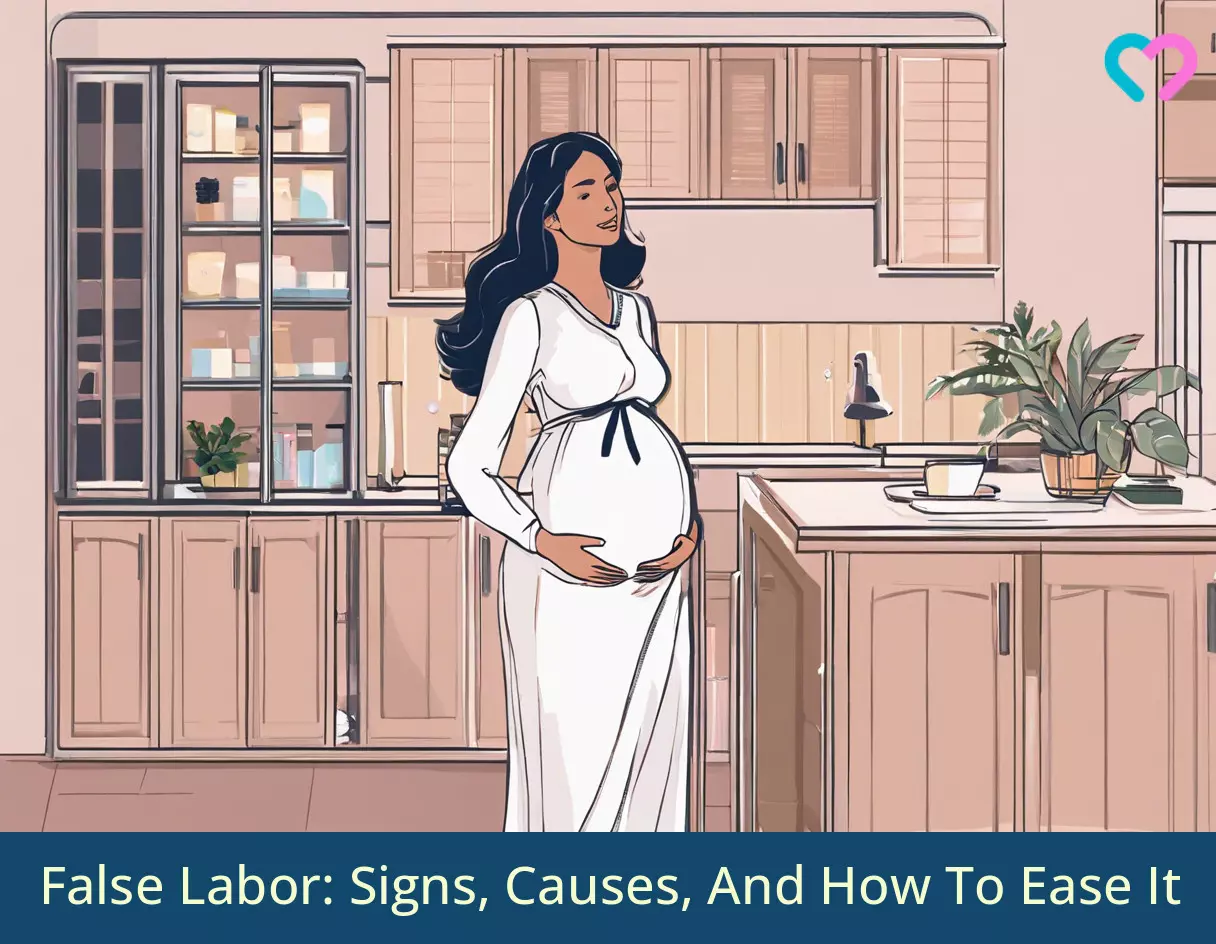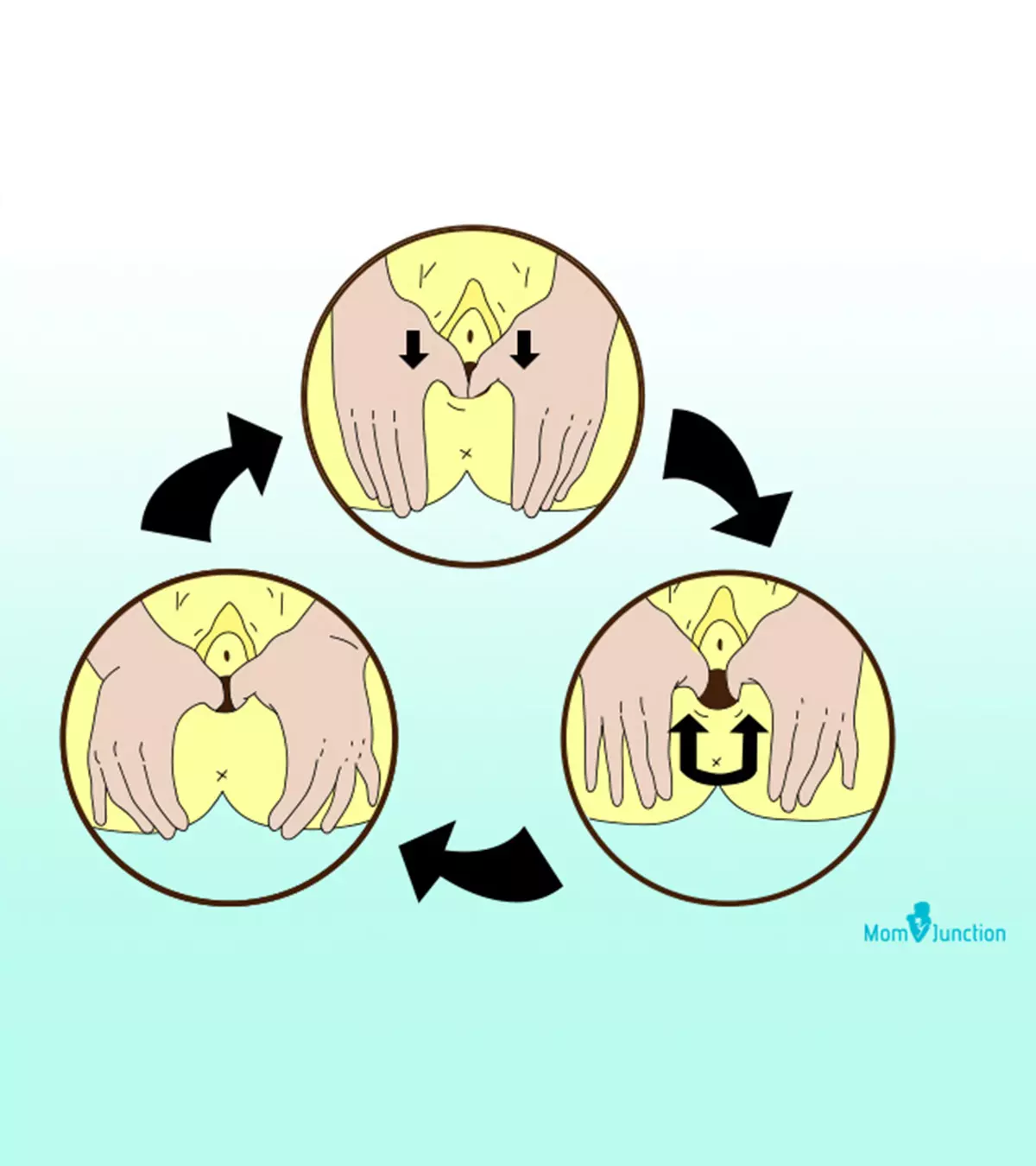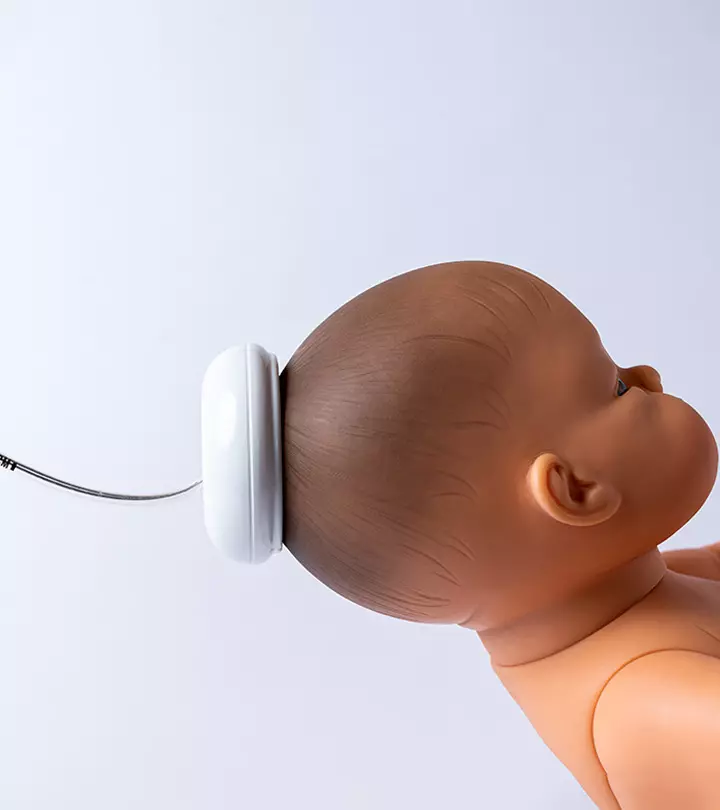
Image: iStock
As your due date approaches, you begin to guard for every possible sign of labor, thinking if it is real labor or just a mock drill. However, differentiating between real and false labor is quite difficult because some signs and contractions are identical in both scenarios. Therefore, it’s critical to distinguish fake labor so you don’t stress out every time you have one or dismiss actual labor as simply another instance of your body’s mock drill. This post explains the indicators of erroneous labor signs and tells you the differences between false and real ones.

Key Pointers
- False labor, also known as Braxton Hicks contractions, occur in the later stages of pregnancy and are often mistaken for real labor.
- False labor can be distinguished from real labor by irregular contractions, tightening of the abdomen, and the absence of water breaking.
- Dehydration, sexual intercourse, physical activity, or a full bladder can trigger Braxton Hicks contractions.
- Pain relief for false labor can be achieved through rest, hydration, light exercise, or a massage.
- If you experience vaginal bleeding, water breaking, or decreased baby movements, contact your healthcare provider.
What Is False Labor?
False labor pains, also known as Braxton Hicks contractions or prodromal labor, are a precursor to true labor.
However, prodromal labor slightly differs from false labor. Prodromal labor is a type of false labor that occurs in the third trimester and can occur weeks before you go into active labor. Just like actual labor contractions, they are painful and may come every five minutes (8). However, false labor can occur as early as the fourth month but become frequent as your due date approaches. These contractions signify false labor as there is a pain but no dilation of the cervix.
However, the false labor does not occur in every pregnant woman. But if you do have contractions before your due date, then it is good to know whether or not they are false (1).
What Are The Signs Of False Labor?

Here are a few signs to identify false labor or pseudo-labor (2):
- Irregular contractions
- Tightening in the abdomen
- No water break. If you notice any leakage of fluid that smells like ammonia, then it is urine and not amniotic fluid (it is odorless).
- Occurs a few times in a day, and towards the later stage, it can occur every 10 to 20 minutes.
- No bleeding
As mentioned above, not every woman will go through false labor, but in certain cases, you are more likely to experience them.
What Triggers A False Labor?

False labor often starts due to (1):
- Physical activities like climbing stairs
- Sexual intercourse
- Full bladder when you wake up in the morning
- If you are dehydrated or have a fever
- Your baby’s movements in the uterus or stress to fetus
 Point to consider
Point to considerSo, how do we differentiate between false and true labor? Let’s learn more about the signs of labor in each case.
How Do Braxton Hicks Or False Labor Contractions Feel Like?

Braxton Hicks contractions are practice contractions that help the uterus prepare for labor and delivery. A squeezing sensation in the lower abdomen or groin or stomach tightening during pregnancy is commonly mistaken for true labor contractions. These contractions do not continue for long; they neither get stronger nor closer with time (3). If these contractions are felt towards the last weeks of pregnancy, they may indicate that true labor is not very far.
 Quick fact
Quick factHow Do True Labor Contractions Feel Like?
The contractions of true labor are an ache or discomfort in your back and in the lower abdomen.
You may experience pressure in the pelvic area. In some pregnant women, the pain is felt in the thighs. It comes at regular intervals and then gets closer and stronger over time. Each contraction lasts for 30-70 seconds (4). Interestingly, the first phase of the first stage of labor is called pre-labor, early labor, or latent labor. In this stage, the discomfort level is low and the cervix usually dilates and effaces (5).
By now, you may have noticed that there are subtle differences between false and true labors. Let us see a few more pronounced differences between them.
What Is The Difference Between True And False Labor?
The following chart will help you figure out the differences (6)(7):
| Signs | True labor | False labor |
|---|---|---|
| Frequency of contractions | Contractions occur at regular intervals. They get closer over time | They are irregular and do not get closer |
| Intensity of contractions | The frequency and intensity of contractions increase with time, irrespective of any activities | Contractions may get weaker or stronger depending on your activities or change in position |
| Time of contractions | Last for 30-70 seconds and progressively increase | Vary in length |
| Center of contractions | The contraction starts in the lower back and moves to the abdomen | The contraction centers in your lower abdomen and groin |
| Change in cervix | The cervix is dilated | Does not cause dilation of the cervix |
| Vaginal discharge (bloody show) | Slightly pinkish or bloody discharge from vagina due to cervical changes | No discharge |
By keeping a close watch on the above-mentioned differences, you can identify the type of labor pain you are experiencing at that point. False labor can be a real discomfort during the last weeks of pregnancy, but you can ease the pain.
Stefanie, a mom of five, shares how she realized what she was experiencing was true labor. She says, “I started having the same pre-labor symptoms I’d been having every day for almost two weeks. It began in the early afternoon, but it felt no different.”
During the day, she noticed that her contractions were regular and lasting longer than usual. She was experiencing a painful contraction every nine minutes. She was hesitant to believe it was actual labor because of several false alarms in the previous days. She thought that as soon as she went to bed, the painful contractions would stop, as they always did. However, they didn’t.
She adds, “After an hour of timing contractions and trying to see if they would stop by changing positions or taking a bath, we decided to head to bed around 11 PM to sleep. I fully expected the contractions to stop, but I ended up lying in bed, timing the contractions every six to seven minutes. They were really hurting by that point, so it began to dawn on me that this was probably real labor (i).”
Tips To Ease A False Labor

Here are some tips to help you overcome the uneasiness (1):
- Go for a walk
- Change positions while lying down
- Take rest or change activity levels
- Drink plenty of water
- Take a warm bath to relax your body
- Get a massage done
- Relax reading book or listening music
- Take a nap
- Practice deep breathing exercises to alleviate stress and pain
 Quick tip
Quick tipThe pain should subside with these simple measures. However, if the contractions are regular and do not decrease even after your efforts, then see a doctor.
When To Call The Doctor?
It is important to contact the doctor if you notice (6):
- vaginal bleeding in bright red color
- continuous leaking of fluid or water break
- contractions felt every five minutes for more than an hour
- any significant change in the baby’s movement, such as less than 6-10 movements in an hour
- inability to walk due to contractions
Frequently Asked Questions
1. Can false labor cause dilation?
No. False labor may lead to the ripening of the cervix to a certain extent but does not cause dilation.
2. What is silent labor?
Silent labor is when the would-be mother does not realize that she is in labor.
3. How long does prodromal labor last?
The duration of prodromal labor isn’t fixed and may vary among individuals and pregnancies. Typically starting around 37 weeks, there’s no set timeframe for how long it lasts. Episodes of prodromal labor may extend for several days at a stretch (8). They might follow a regular pattern, occurring at the same time each day or in consistent intervals. If you are experiencing contractions during pregnancy and are unsure whether it is true labor or prodromal labor, it’s advisable to contact your healthcare provider for guidance.
4. Can false labor lead to preterm labor or complications during pregnancy?
False labor or Braxton Hicks contractions cannot induce labor or cause any harm to the pregnancy or the baby. These false contractions towards the later stages of pregnancy prepare the body for work but do not cause cervix dilation, unlike true labor (1) (9).
5. Can false labor be prevented?
It may not be possible to prevent false labor, as it is present in all pregnancies. However, certain factors such as staying hydrated, using relaxation techniques, and avoiding intense activity may help manage the discomfort (1).
As you approach the third trimester and your due date, the thought of delivery may excite and worry you. However, the false labor contractions you experience during this stage may accelerate your anxiety. Hence, the above methods would help you distinguish between false and true contractions. Usually, the frequency of the contractions is an indication. However, note that not all women may experience these Braxton Hicks contractions. Hence, look for the other accompanying signs such as water breakage, the regularity of the contractions, and cervical changes. If you’re unsure about the contraction, you can always call your obstetrician and report the symptoms.
Infographic: Ways To Manage The Signs Of False Labor
As you are nearing your due date, one of the complications you may face is experiencing false labor. This can be frustrating and confusing for expectant mothers. The infographic below provides effective strategies to manage false labor signs at home. However, contact your doctor if the symptoms are persistent.
Some thing wrong with infographic shortcode. please verify shortcode syntaxIllustration: False Labor: Signs Causes And How To Ease It

Image: Stable Diffusion/MomJunction Design Team
Seek out the techniques to distinguish true and false labor, comprehending their distinct indications and symptoms. Gain valuable advice on effectively discerning between these two types of labor.
Personal Experience: Source
MomJunction articles include first-hand experiences to provide you with better insights through real-life narratives. Here are the sources of personal accounts referenced in this article.
i. Liliana’s birth story.https://www.lexieloolilyliamdylantoo.com/2011/08/lilianas-birth-story.html
References
- Braxton Hicks Contractions.
https://www.ncbi.nlm.nih.gov/books/NBK470546/ - False Vs True Labor: How To Tell The Difference.
https://intermountainhealthcare.org/blogs/false-vs-true-labor - The Uterine Contraction Pattern Of False Labor And Its Relation To Premature Labor.
https://www.ajog.org/article/S0002-9378(43)90436-3/fulltext - Contractions And Signs Of Labor.
https://www.marchofdimes.org/find-support/topics/birth/contractions-and-signs-labor - Overview of Labor
https://www.stanfordchildrens.org/en/topic/default?id=overview-of-labor-90-P02896 - Other Labor And Delivery FAQs.
https://www.nichd.nih.gov/health/topics/labor-delivery/more_information/questions - False Alarm: Braxton Hicks Contractions Vs. True Labor.
https://utswmed.org/medblog/braxton-hicks-contractions/ - Prodromal Labor.
https://my.clevelandclinic.org/health/symptoms/24163-prodromal-labor - Braxton Hicks Contractions.
https://my.clevelandclinic.org/health/symptoms/22965-braxton-hicks - Braxton Hicks Contractions.
https://americanpregnancy.org/healthy-pregnancy/labor-and-birth/braxton-hicks/
- Braxton Hicks Contractions.
Community Experiences
Join the conversation and become a part of our nurturing community! Share your stories, experiences, and insights to connect with fellow parents.
Read full bio of Dr. Shivani Chaturvedi
Read full bio of shreeja pillai
Read full bio of Rebecca Malachi
Read full bio of Dr. Joyani Das
















